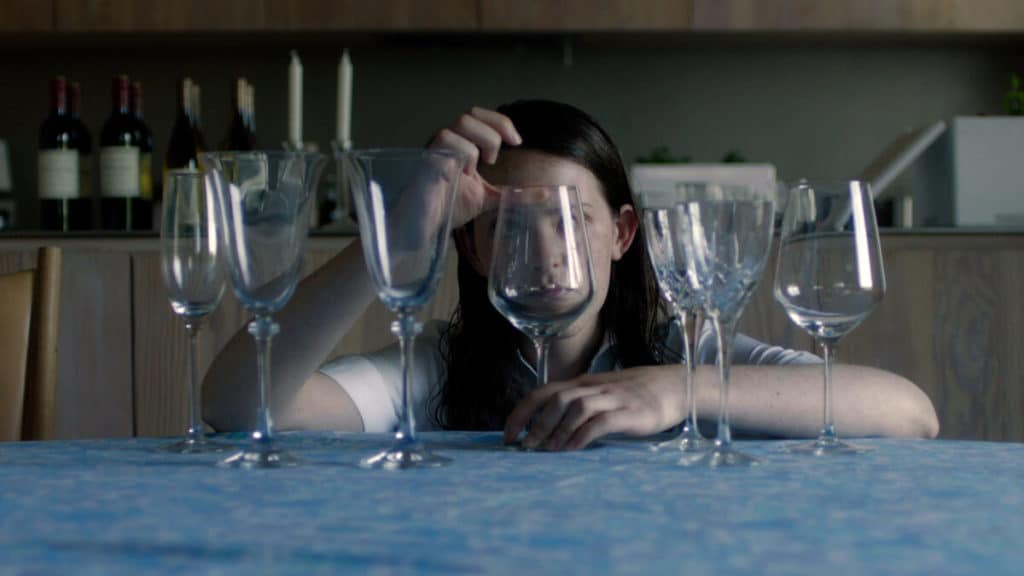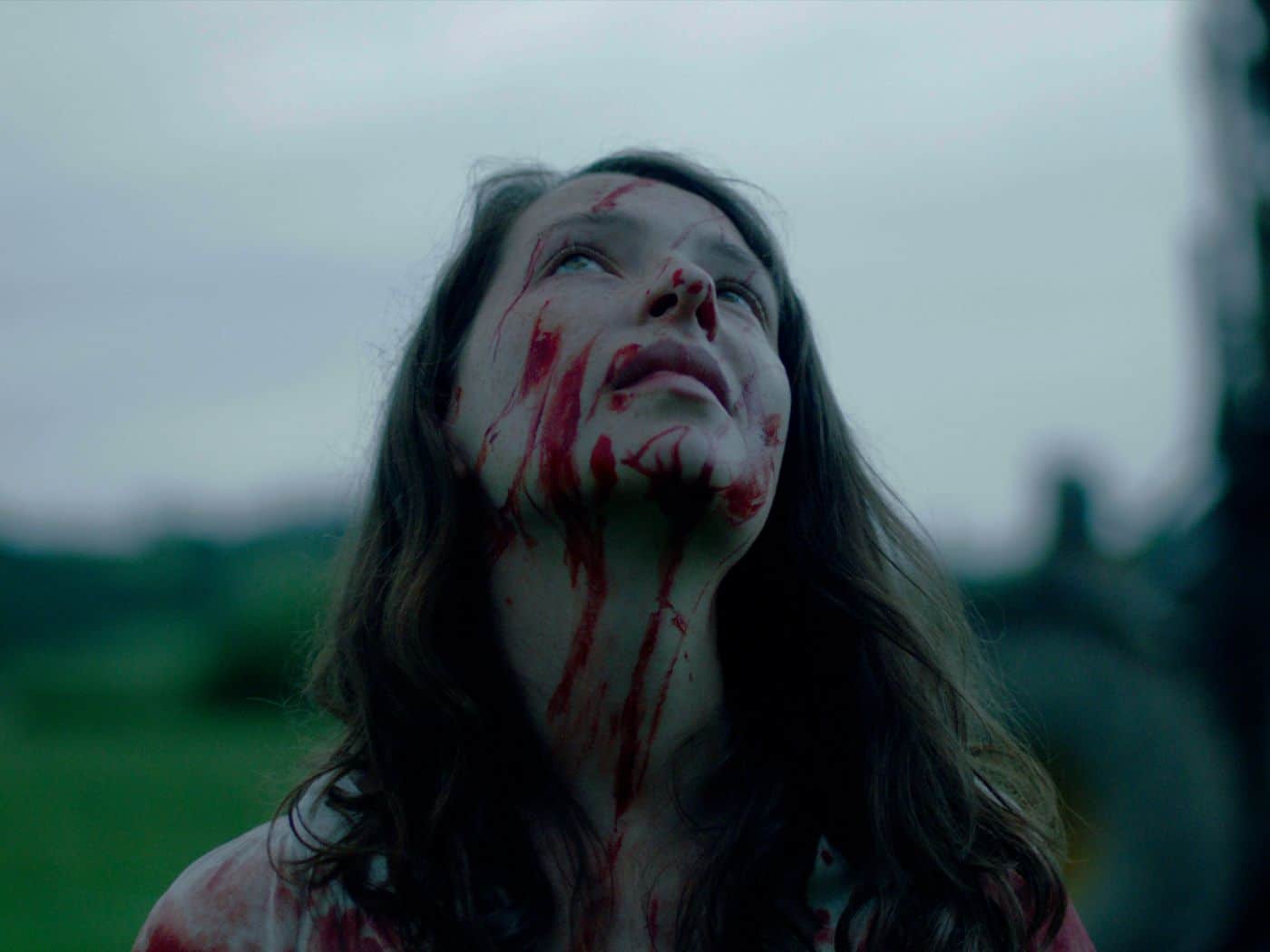
The Feast (Gwledd) is a Welsh-language horror about place and ‘progress’; as such, it bears many of the hallmarks of folk horror, though it never neatly expounds all of these elements. It doesn’t divulge everything; perhaps it doesn’t need to. However, its message is still bloodily clear and familiar: tradition and folklore are more than just stories here. Instead, they are positioned as codes, there to keep those in the know safe – and to punish transgressors.
In an immaculate, modern house in rural Wales, a woman, Glenda (Nia Roberts) and a young man, son Gweirydd (Sion Alun Davies) show that they have the time and means to indulge themselves; it’s a stark, isolating kind of luxury, but luxury still, and this is a big day for the household. Glenda and her husband Gwyn (Julian Lewis Jones), who is the local MP, have a big dinner planned. To facilitate this, they have hired a local girl called Cadi to assist, as their usual helper is unavailable. Cadi (Annes Elwy) doesn’t make a great first impression: she arrives late, her hair still wet, and overall a little dishevelled (regular horror viewers will raise an eyebrow at her crisp, pristine white shirt, because we all know it ain’t staying like that.) Preparations for the meal begin: Glenda has a long list of expectations, it seems, which Cadi has to take on board very rapidly. Clearly, though, there are some issues with Cadi: she mutely receives the demands made of her, is prone to flights of fancy and seems overall to regard everything in the house as a new experience, although she reacts with revulsion when Gwyn arrives home with a brace of rabbits he lies about having personally killed.
In the meantime, the strained family dynamic becomes clearer; both Gweirydd and his brother Guto (Steffan Cennydd) are not exactly willing residents at home, and between father, mother and sons there is a tangle of issues – disappointments, secrets, frustrations. What better, then, than the nexus of the dinner table to bring these issues to light? The dinner is important because two of their guests are involved, wittingly or otherwise, in Gwyn’s plans for the farmland they are exploiting for resources. Already the old family farm – where Glenda grew up – has been flattened to make way for the new house, but this is by no means the end of the process as they see it. Cadi’s presence begins to exacerbate the tensions – there is an element of sexual unease around her role in the household – and the meal becomes a nightmare of symbolic, horrific proportions, though it feels as though some level of ‘nightmare’ was coming regardless of how, exactly.
This house – actually an architectural project by John Pawson called the Life House, in Llanbister – is a great location, used well to show how this family has made an artform out of artifice. Nothing seems anything more than superficial, whether it’s Glenda peeling off a face mask in the sanctuary that guest Mair regards, astounded, as a self-built ‘prison cell’, or it’s would-be triathlete Gweirydd preparing for the race on a static bike, albeit set up outside. Questions about these people bubble to the surface and linger. Stains and scuffs disrupt the surface perfection throughout the first act of the film, overtly suggesting more disruption to come. The visual clues are many.
There are some issues with the film’s approach in places: there’s some disparity between the swathes of slow-mo symbolism and the upfront awfulness of dinner guest Euros (Rhodri Meilir), for example, as he rattles out a list of his status symbols as soon as he turns up (which, now I think of it, is not even the first scene which reminded me, tangentially, of American Psycho – the same empty-headed materialism is there). The chaptering of the film is a needless affectation, as it always is – but regardless of this, this is a very beautiful film with a developed awareness of how to compose shots, how to light them, and where to focus. To add in another point of comparison, some of the shots and subject matter are similar to Ruth Paxton’s A Banquet (2021), though The Feast takes its own direction, becoming more overt in its horror. It remains slow-burn, though, never fully giving way to the more graphic, shocking content, even while it tantalises it.
Perhaps most of all, the film succeeds in making an allegory out of a modernising Wales; of course, many other countries have similar stories, but The Feast explores what happens to a country – symbolised by the family – which embraces change to the point of regarding the past as, to quote Glenda, “primitive”. That’s especially resonant as a South Walian, where – by the 1960s, when the Valleys and surrounding areas were at the peak of their industrial wealth – the majority of the young population spoke almost exclusively in English. Case in point: I couldn’t understand more than a handful of words in The Feast, as both a Welsh native and non Welsh speaker, something which has always torn at both the romantic and pragmatic sides of my nature. But I digress: the shifting use of the language has certainly been associated with a modernising, changing country – for good or ill – and as such, the use of Welsh in the film is, I think, significant: Wales is and has long been a quietly contested place, a country with a turbulent and often self-effacing history, one which is often overlooked, even within the UK. It lacks the greater bombast of Scottish history and identity perhaps, and of course has suffered nothing like the open warfare seen on the streets of Northern Ireland, but Welsh history has more than enough to anger, to shock, to sadden. The Feast uses the symbolic language of horror to illustrate something of this, and it’s in this that I think it really shines. Anxieties over the land, family, tradition, mythology and values seep slowly through the film; these are familiar in many respects but also, somehow, inextricably Welsh. It’s a visually rich, beguiling watch.
The Feast (2021) will be released in cinemas on August 19th 2022.
